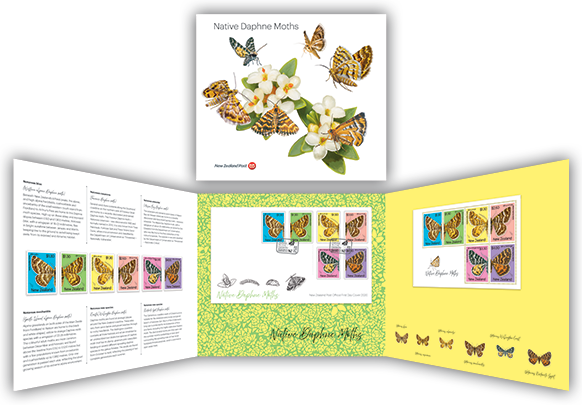This is an unusual stamp issue in that the stamp only contains half of each moth. Sure, we can be certain that the other missing half would identical as that is how things work with moths and butterflies. But I don't think I have ever seen half a moth or butterfly on a stamp before.
Daphne moths are colourful, day-flying species with wingspans between 18 and 26 millimetres, characterised by constantly vibrating their neatly patterned wings when they are active on sunny days. They are often seen sunbathing on bare surfaces, feeding on nectar or carefully laying their eggs on the right plant during periods of bright sunshine.
Their caterpillars feed on the foliage of just one family of plant, which includes the two New Zealand genera of daphne – Pimelea and Kelleria – while the adults take nectar from the sweet-smelling flowers of their hostplants. Together with their daphne hostplants, they are often numerous in naturally open habitats from the coastline – sand dunes, gravel beaches and rocky headlands – through inland short-tussock grasslands, to a range of open habitats above the treeline such as alpine grassland, herbfields, cushionfields and snowbanks.
The Stamps.
$1.30 - Notoreas blax.
The Western alpine Daphne moth flies in bright sunshine between January and March, keeping low to the ground to avoid being swept away from its exposed and dynamic habitat beneath New Zealand’s loftiest peaks.
$1.30 - Notoreas casanova.
The Foveaux Daphne moth was discovered in 1982 and formally named in 2010. It is only known to inhabit Tiwai Peninsula, Fortrose Spit and Three Sisters Sand Dune.
$1.30 - Notoreas edwardsi.
With a wingspan of about 20 millimetres, the recently discovered and described Mason Bay Daphne moth is named for Eric Edwards from the Department of Conservation, who was the first to find the caterpillars of this colourful species.
$2.60 - Notoreas mechanitis.
Alpine grasslands on both sides of the Main Divide from Fiordland to Nelson are home to the black-and-white-striped, yellow-to-orange South Island alpine Daphne moth.
$3.30 - Notoreas new species.
The Wellington coastline’s sand dunes, gravel beaches and rocky headlands are all inhabited by an undescribed but distinctive species of Daphne moth whose plump, greenish-pink caterpillars feed on several different sprawling daphne species in the genus Pimelea.
$4.00 - Notoreas new species.
The Canterbury coastline south of Christchurch is notable for the extensive sand dunes and gravel beach of Kaitorete Spit. Much of the 25 kilometre long spit is protected for its biodiversity of flora and fauna, including this highly distinctive Kaitorete Spit Daphne moth.
Other Collectable Items.
First Day Cover - 5 February 2020.
The First Day Cover shows the life cycle of a moth.
Miniature Sheet.
Miniature Sheet First Day Cover - 5 February 2020.
Presentation Pack.
Discover the fascinating daphne moths of New Zealand with this presentation pack. With these vivid stamps designed by Wellington artist Stephen Fuller and commentary by moths and butterflies expert Brian Patrick, you’ll get an insight into six of the 35 species found around New Zealand. The pack comes with a full set of six gummed stamps, a miniature sheet and a first-day cover.
Limited Edition.
With this Limited Edition, you’ll learn more about the daphne moth species. Contributor Brian Patrick has held a lifelong fascination for caterpillars, the plants they fed on, and adult moths and butterflies. He now has a database of nearly 4,000 field trips he has carried out nationwide in the pursuit of knowledge of our diverse Lepidoptera fauna and its specialised habitats and host plants. This Limited Edition includes an informative booklet written by Brian as well as all six stamps, colour separation of the $4.00 stamp, a numbered miniature sheet, and a signed first-day cover.
Set of Plate Blocks. Set of Value Blocks.
Set of Full Sheets.
Technical information.
Date of issue: 5 February 2020.
The number of stamps: Six gummed stamps.
Denominations: $1.30 x3, $2.60, $3.30, $4.00.
Stamps, miniature sheet and first day covers designed: Stephen Fuller, Wellington, New Zealand.
Printer: Southern Colour Print, New Zealand.
The number of colours: Four process colours plus overgloss with special fluro colour per stamp.
Stamp size and format: 30mm x 40mm (vertical)
Paper type: 104g Tullis Russell Red-Phosphor gummed stamp paper
The number of stamps per sheet: 25.
Perforation gauge: 14 x 14.
Period of sale: These stamps remained on sale until 4 February 2021. First-day covers remained on sale until 31 March 2020.
Some of the images in this post were used with permission from the illustrated catalogue of StampsNZ
You can visit their website and Online Catalogue at, http://stampsnz.com/
Information & images for this post came from.















Half a moth? What happened to the other half. Did somebody eat it? LOL
ReplyDeleteAnne
We appreciate your engagement with our content. To ensure a respectful and constructive community, please take note of the following:
- No Spam, Please: We do not tolerate spammy or promotional comments. Any such comments will be promptly removed.
- Moderation in Place: All comments are moderated to maintain a positive and inclusive environment. Please be patient, as it may take a little time for your comment to appear.
- Sign In with Google: To comment, please sign in using your Google account. This helps us maintain the integrity of our community and allows for better interaction.